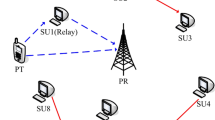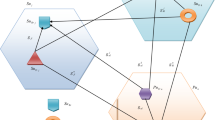Abstract
Wireless networks are burdened with the demand of providing higher data rates for the user devices connected to the wireless networks. This demand presents a huge challenge for the traditional radio resource constrained wireless communication networks. The cognitive radios and cooperative communication techniques have emerged to offer promising solutions to the burden of higher data rate demands. This paper addresses the problem of radio resource management in cooperative cognitive radio relay networks (CCRRN). In resource-constrained networks, a uniform bandwidth allocation scheme may not be efficient for the connected wireless multi-users. In this paper, a convex optimization analytical framework is used to investigate the problem of radio resource management in CCRRN. A joint optimal resource allocation (JORA) for power and bandwidth allocation strategy for the maximization of the total throughput capacity of all users in the networks is proposed. The formulated radio resource management problem is proved to be a standard convex optimization problem. The convex optimization problem is solved efficiently using the SNOPT solver package. The SNOPT solver is implemented in the MATLAB/TOMLAB software environment. The numerical results showed that the JORA scheme significantly outperformed the equal bandwidth (EQBW) scheme in terms of throughput capacity.






Similar content being viewed by others
References
F. A. Awin, Y. M. Alginahi, E. Abdel-Raheem and K. Tepe, Technical issues on cognitive radio-based internet of things systems: A survey, IEEE Access, Vol. 7, pp. 97887–97908, 2019.
T. Huang, W. Yang, J. Wu, J. Ma, X. Zhang and D. Zhang, A survey on green 6g network: Architecture and technologies, IEEE Access, Vol. 7, pp. 175758–175768, 2019.
H. Ullah, N. G. Nair, A. Moore, C. Nugent, P. Muschamp and M. Cuevas, 5g communication: An overview of vehicle-to-everything, drones, and healthcare use-cases, IEEE Access, Vol. 7, pp. 37251–37268, 2019.
H. Beenish, and M. Fahad, 5g a review on existing technologies, in 2019 2nd International Conference on Computing, Mathematics and Engineering Technologies (iCoMET), pp. 1–6, 2019.
S. Rizvi, A. Aziz, M. T. Jilani, N. Armi, G. Muhammad, and S. H. Butt, An investigation of energy efficiency in 5g wireless networks, in 2017 International Conference on Circuits, System and Simulation (ICCSS), 2017, pp. 142–145.
Mamane, M. E. Ghazi, G. Barb, and M. Oteṣteanu, 5g heterogeneous networks: An overview on radio resource management scheduling schemes, in 2019 7th Mediterranean Congress of Telecommunications (CMT), 2019, pp. 1–5.
D. Nezník, L. Doboš, and J. Papaj, Radio resource management for wireless networks, in 2019 29th International Conference Radioelektronika (RADIOELEKTRONIKA), 2019, pp. 1–6.
E. Z. Tragos, S. Zeadally, A. G. Fragkiadakis and V. A. Siris, Spectrum assignment in cognitive radio networks: A comprehensive survey, IEEE Communications Surveys & Tutorials, Vol. 15, pp. 1108–1135, 2013.
Ridhima and A. S. Buttar, Fundamental operations of cognitive radio: A survey, in 2019 IEEE International Conference on Electrical, Computer and Communication Technologies (ICECCT), 2019, pp. 1–5.
H. T. Madan, and P. I. Basarkod, A survey on efficient spectrum utilization for future wireless networks using cognitive radio approach, in 2018 4th International Conference on Applied and Theoretical Computing and Communication Technology (iCATccT), 2018, pp. 47–53.
R. Kaur, A.S. Buttar, and J. Anand, Spectrum sharing schemes in cognitive radio network: A survey, in 2018 Second International Conference on Electronics, Communication and Aerospace Technology (ICECA), 2018, pp. 1279–1284.
D. Xu and H. Zhu, Sum-rate maximization of wireless powered primary users for cooperative crns: Noma or tdma at cognitive users?, IEEE Transactions on Communications, Vol. 69, pp. 1–1, 2021.
S. Bhandari, and S. Joshi, Cognitive radio technology in 5g wireless communications, in 2018 2nd IEEE International Conference on Power Electronics, Intelligent Control and Energy Systems (ICPEICES), 2018, pp. 1115–1120.
F. Hu, B. Chen and K. Zhu, Full spectrum sharing in cognitive radio networks toward 5g: A survey, IEEE Access, Vol. 6, pp. 15754–15776, 2018.
M. Zhang, G. Zhang, S. Zhang, and Z. Bao, An optimized resource allocation algorithm in cooperative relay cognitive radio networks, in 2017 Signal Processing Symposium (SPSympo), 2017, pp. 1–6.
M.W. Baidas, and M.R. Amini, Network sum-rate maximization via joint relay selection and power allocation in energy-harvesting noma multicast cognitive radio networks, in 2020 International Conference on Communications, Signal Processing, and their Applications (ICCSPA), 2021, pp. 1–6.
X. Liu and W. Du, Energy-efficiency-based power allocation scheme in multi-user single-df-relay cognitive networks, Wireless Personal Communications, Vol. 114, No. 3, pp. 1927–1941, 2020. https://doi.org/10.1007/s11277-020-07455-3.
Y. Li, P. Wang, and D. Niyato, Optimal power allocation for secondary users in cognitive relay networks, in 2011 IEEE Wireless Communications and Networking Conference, 2011, pp. 862–867.
A. Savard and E. V. Belmega, Optimal power allocation policies in multi-hop cognitive radio networks, in 2020 IEEE 31st Annual International Symposium on Personal, Indoor and Mobile Radio Communications, 2020, pp. 1–6.
W. Xu, Y. Gao, Y. Wang, and J. Lin, Power allocation with min-rate guarantee for ofdm-based cognitive radio systems, in 2013 8th International Conference on Communications and Networking in China (CHINACOM), 2013, pp. 959–962.
L. Wang, W. Xu, K. Niu, Z. He, J. Lin, and B. Tian, Multiuser power allocation for ofdm-based cognitive radio network, in 2011 International Conference on Wireless Communications and Signal Processing (WCSP), 2011, pp. 1–4.
A. Limmanee, and S. Dey, Optimal power policy and throughput analysis in cognitive broadcast networks under primary’s outage constraint, in 2012 10th International Symposium on Modeling and Optimization in Mobile, Ad Hoc and Wireless Networks (WiOpt), 2012, pp. 391–397
Y. Wang, W. Xu, K. Yang and J. Lin, Optimal energy-efficient power allocation for ofdm-based cognitive radio networks, IEEE Communications Letters, Vol. 16, pp. 1420–1423, 2012.
Y. Xu, Y. Hu, Q. Chen and S. Zhang, Optimal power allocation for multiuser ofdm-based cognitive heterogeneous networks, China Communications, Vol. 14, pp. 52–61, 2017.
P. Lan, L. Chen, G. Zhang and F. Sun, Optimal resource allocation for cognitive radio networks with primary user outage constraint, EURASIP Journal on Wireless Communications and Networking, Vol. 2015, No. 1, pp. 239, 2015. https://doi.org/10.1186/s13638-015-0465-4.
T. X. Quach, H. Tran, E. Uhlemann, G. Kaddoum and Q. A. Tran, Power allocation policy and performance analysis of secure and reliable communication in cognitive radio networks, Wireless Networks, Vol. 25, No. 4, pp. 1477–1489, 2019. https://doi.org/10.1007/s11276-017-1605-z.
X. Liu and M. Jia, Intelligent spectrum resource allocation based on joint optimization in heterogeneous cognitive radio, IEEE Transactions on Emerging Topics in Computational Intelligence, Vol. 4, pp. 5–12, 2020.
R. Xie, H. Ji, P. Si, M. Li, and Y. Li, Optimal joint power and transmission time allocation in cognitive radio networks, in 2010 IEEE Wireless Communication and Networking Conference, 2010, pp. 1–5.
X. Wang, S. Ekin and E. Serpedin, Joint spectrum sensing and resource allocation in multi-band-multi-user cognitive radio networks, IEEE Transactions on Communications, Vol. 66, pp. 3281–3293, 2018.
S. Thakur and A. Singh, Underlay cognitive radio with instantaneous interference constraint: A secrecy performance, IEEE Transactions on Vehicular Technology, Vol. 70, No. 8, pp. 7839–7844, 2021.
D. Bepari and D. Mitra, Performance of ga in power allocation for underlay cognitive radio systems, Journal of Communications Technology and Electronics, Vol. 63, No. 10, pp. 1250–1258, 2018. https://doi.org/10.1134/S1064226918100042.
G. Philip, M. Walter, and S. Michael, Systems optimization laboratory,stanford university dept of management science and engineering, October, 4, 2022.
H. Kenneth, G. Anders, and E. Marcus, Tomlab optimization for fast and robust large-scale optimization in matlab, October, 4, 2022.
A. Shome, A. K. Dutta and S. Chakrabarti, Ber performance analysis of energy harvesting underlay cooperative cognitive radio network with randomly located primary users and secondary relays, IEEE Transactions on Vehicular Technology, Vol. 70, pp. 4740–4752, 2021.
Author information
Authors and Affiliations
Corresponding author
Additional information
Publisher's Note
Springer Nature remains neutral with regard to jurisdictional claims in published maps and institutional affiliations.
Appendix
Appendix
Negative semi-definite functions are concave functions. Our goal is to prove that the objective function of the optimization problem is a negative semi-definite function. A function F(x, y) is negative semi-definite if and only if the eigenvalues ( \(\lambda _l\)) of the Hessian of F(x, y) are non-positive. That is \(\lambda _l \le 0, l=1,2,\ldots L.\), where L is the dimension of the Hessian matrix of F(x, y). Note that at least one of the eigenvalues must be zero. Let the achievable rate in the first-transmission time slot be denoted as \(F_1(b_1,p_1)\) and \(F_1(b_1,p_1)\Rightarrow AR^i_{SR_k}\), where \(b_1 \equiv B^i_S\), \(g_1 \equiv G^i_{SR_k}\) and \(p_1 \equiv P^i_S\), similarly let the achievable rate in the second transmission time slot be denoted as \(F_2(b_2,p_2)\) and \(F_2(b_2,p_2)\Rightarrow AR^i_{R_kD_i}\), where \(b_2 \equiv B^i_{R_k}\), \(p_2 \equiv P^i_R\) and. We need to prove that \(F_1(b_1,p_1) = b_1 \log (1+ \frac{p_1 g_1}{N_0b_1})\) and \(F_2(b_2,p_2) = b_2 \log (1+ \frac{p_2 g_2}{N_0b_2})\) are concave functions.
Firstly, we prove that \(F_1(b_1, p_1)\) is negative semi-definite. We define the Hessian matrix \(H_{F_1(b_1,p_1)}\) as;
Therefore, we have the Hessian matrix \(H_{F_1(b_1,p_1)}\) as;
The eigenvalues \(\lambda _1\) and \(\lambda _2\) of \(H_{F_1(b_1,p_1)}\) are the first principal minors of \(H_{F_1(b_1,p_1)}\). Hence,
The last eigenvalue \(\lambda _3\) is the determinant of the Hessian matrix
Therefore, with \(\lambda _1 <0\), \(\lambda _2 <0\) and \(\lambda _3 = 0\), consequently \(H_{F_1(b_1,p_1)}\) is negative semi-definite and hence, \(AR^i_{SR_k}\) is a concave function in \(B^i_S\) and \(P^i_S\).
Secondly, we prove that \(F_2 (b_2, p_2)\) is negative semi-definite. Defining the Hessian matrix \(H_{F_2(b_2,p_2)}\) as;
Thus, the Hessian matrix \(H_{F_2(b_2,p_2)}\) is;
The corresponding the eigenvalues \(\lambda _1\) and \(\lambda _2\) of \(H_{F_2(b_2,p_2)}\) are the first principal minors of \(H_{F_2(b_2,p_2)}\). Hence,
while the last eigenvalue \(\lambda _3\) is the determinant of the Hessian matrix
Therefore, with \(\lambda _1 <0\), \(\lambda _2 <0\) and \(\lambda _3 = 0\), thus \(H_{F_2(b_2,p_2)}\) is negative semi-definite and hence, \(AR^i_{R_k D_i}\) is a concave function in \(B^i_{R_k}\) and \(P^i_R\).
Finally, since both \(AR^i_{S R_k}\) and \(AR^i_{R_k D_i}\) are concave functions, therefore, problem \(\textbf{ P1}\) is a convex optimization problem. Consequently, problem \(\textbf{P2}\) is a convex optimization problem.
Rights and permissions
Springer Nature or its licensor (e.g. a society or other partner) holds exclusive rights to this article under a publishing agreement with the author(s) or other rightsholder(s); author self-archiving of the accepted manuscript version of this article is solely governed by the terms of such publishing agreement and applicable law.
About this article
Cite this article
Obayiuwana, E., Ayokunle, O.O. Total Throughput Capacity Maximization in Cooperative Cognitive Radio Relay Networks. Int J Wireless Inf Networks 30, 198–210 (2023). https://doi.org/10.1007/s10776-023-00593-y
Received:
Revised:
Accepted:
Published:
Issue Date:
DOI: https://doi.org/10.1007/s10776-023-00593-y




